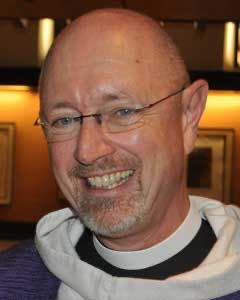For a number of years in the early 2000s, Thomas Roach, then artist-in-residence at Vancouver’s Christ Church Cathedral, created an installation of veils that were draped over the altar area at the conclusion of the Good Friday liturgy. While the congregation and choir sang “Were you there when they crucified my Lord?”, dancers would reverently place grey and black veils—reminiscent of Turin’s famous shroud—over the altar and the cross. It made for a most affecting moment, but it was born of a practical need: to hide Easter flowers and decorations for the Great Vigil. When Easter was proclaimed with the words, “Alleluia, Christ is risen,” the veils would be removed, revealing hundreds of daffodils, lilies and springtime plants—symbols of Christ’s resurrection.
I’ve been thinking about this custom, now years ago at the cathedral, while sheltering at home through the duration of this pandemic. The veiling and the unveiling have resonated as powerful images of what we are currently enduring and what awaits us on the other side of pandemic.
An “unveiling of things not previously known” is the literal meaning of the Greek word apocalypse, and the shutdown of businesses and social activities in much of the world has unveiled conditions that many of us have willingly ignored. Spiritual teacher Chris Dierkes[1] has identified some of these conditions as:
- The recognition that the entire global economic order of offshore labour, “just in time production,” over-leveraged financial instruments and ultra-thin supply lines can be taken down by a virus in a matter of mere weeks.
- That the political classes around the world are not interested in the well-being of their respective populations/citizens. The elites exist for their own well-being at the expense of the masses.
- That the mainstream media and social media are weaponized to create fear, panic and helplessness in the general population.
- That the desecration of the earth will inevitably come back to bite humans in the backside, as we are inextricably creatures of this world and yet imagine we are not.
Agree with Dierkes or make your own list—but there’s no doubt that a veil has been lifted through this time, and human life can now be seen in all its vulnerability and beauty. We’re living through a non-liturgical Passiontide—in both senses of the word “passion”, both suffering and love. The suffering of the ill, the sacrificial love of those who care for the sick and keep supply chains active are both active and present. In these days the image of the suffering Saviour on the cross has a particular and stark relevance for us.

“Sometimes it makes me tremble, tremble, tremble,” sang the congregation on those Good Fridays, as veils were placed over cross and altar; many of us sang these words with lumps in our throats and through tears of grief. We would leave the veils over cross and altar until Saturday—and then the transforming work would begin—and it’s work that we need to anticipate in the next few months. It’s preparing the stage for new life.
Questions cascade as communities prepare for whatever world awaits us once the shutdowns are over: How will we be changed by this experience? What new life will emerge from this encounter with apocalypse? How will the life of our church be different? Will there emerge a new set of shared social values that promote the flourishing of all?
I remember those Holy Saturdays, when dozens of people came into the cathedral to prepare it for the great feast: they drew back the veils and sensitively made the church beautiful for Easter. Once the work was complete, the veils then were artistically replaced, now less shroud-like—and more resembling rocks and boulders, as at a garden tomb. Then, in an apocalyptic moment, at the Great Vigil of Easter, the veils were removed to reveal the beauty of those spring-time flowers symbolic of transformed and resurrected life.
In church communities across the country, lay and clergy leaders are anticipating the time when in-person services and events can safely begin again. As we inch toward the time when social distancing will be no more, I join with others in praying that new ways of being might emerge to help repair and renew the creation. Perhaps the unveiling necessitated by conditions of this time might prove to be the fertile ground of a post-apocalyptic Easter.
[1] Quoted, with permission. Learn more about Chris Dierkes and his work here http://chrisdierkes.com/about-me/





